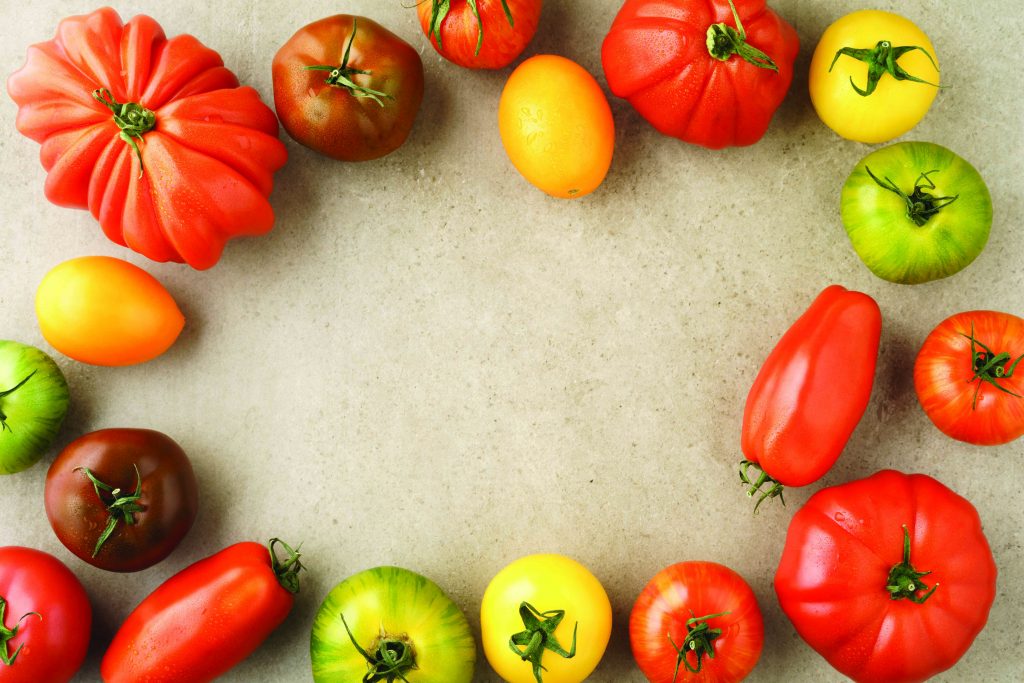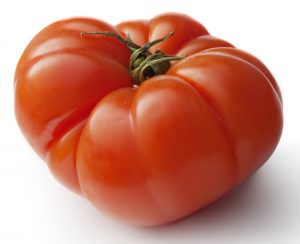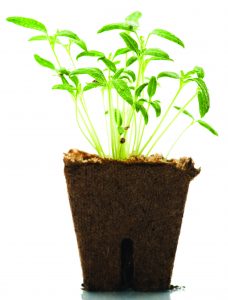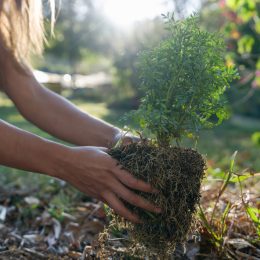
By Brian D. Smith
Call me Mr. Tomato Head. That’s the nickname I earned in a previous job after gathering ripe tomatoes from my backyard garden at the crack of dawn, hauling them to my downtown Indianapolis office, and tempting my co-workers with the offer, “Free to good homes!”
And these were no run-of-the-mill ’maters, mind you. For more than two decades I’ve almost exclusively grown sweet, juicy, old-fashioned varieties with funny names, shapes and colors – otherwise known as heirlooms. Technically speaking, they’re also open-pollinated, which means that unlike hybrids, they produce seeds that grow true to the original.
If you’ve never heard of tomatoes such as Mortgage Lifter, Arkansas Traveler, Cherokee Purple and Hillbilly Potato Leaf, then it’s time to grab a No. 2 pencil and notepad, pull up a tomato crate and find out what Mr. Tomato Head can do for you.
Let’s get one thing settled: I claim no formal expertise in the ways of the tomato. If you aced a Master Gardener class at your local extension office and want to challenge me to a test of horticultural knowledge, you’ll probably win. But look me up in August and we’ll see how your tomatoes compare to mine in a taste test. Fair warning: I’ve had chefs from prestigious Central Indiana restaurants offer to buy my heirlooms if I could grow them in greater quantities (which, unfortunately, I can’t without digging up most of my backyard). Heck, my tomatoes even won top prize at the Conner Prairie Country Fair.
You’re undoubtedly wondering how I transformed from a mild-mannered consumer of store-bought tomatoes into Mr. Tomato Head. Well, it didn’t happen overnight.
If you want it done right
My passion for tomatoes took root with the first tomato plants I ever grew, as a boy of maybe 13. Until then my concept of tomatoes came from the red tennis balls my family purchased at the local grocery and the soggy slices that slithered between the buns of my fast-food burgers.

But that summer, in the modest suburban backyard of my Franklin home, I spaded a strip of our concrete soil into a small garden and dropped a couple of tomato seedlings into the space. Two months later I proudly harvested my first tomato. But as I lifted that first slice to my lips, I was wholly unprepared for the explosion of sweet juiciness that would tantalize my taste buds.
Wow – so this was the way tomatoes really tasted? I felt like Dorothy in “The Wizard of Oz” when she stepped through the door of her sepia surroundings into a world transformed by Technicolor. Every home garden I grew from then on included tomato plants.
But my graduation from college led to nearly two decades of apartment living, during which I never planted another garden. It took a disappointing stop at a roadside stand to send me back to the soil.
The fateful incident occurred in October 1995, shortly after I bought a house (my first) in New Whiteland. A tempting display of ripe, farm-grown tomatoes coaxed me off a nearby rural road, and I was soon opening my wallet and carting home my anticipated delights. Instead, I bit into the same blandness that usually seeped out of their store-bought cousins.
Exasperated, I realized the veracity of the classic expression: “If you want something done right, do it yourself.” The following May again found me in shovel-wielding stance, attacking the backyard dirt with a renewed sense of purpose as I cleared space for hybrid seedlings such as Jet Star and Celebrity. I was pleased with the initial results, but not overjoyed.
Truth be told, despite the improved flavor of my homegrown bounty, I couldn’t shake the nagging feeling that my latter-day versions still hadn’t matched the scrumptiousness of the ones I’d grown in my youth. Or was it just the fog of nostalgia?
From hybrids to heirlooms
My interest in heirloom tomatoes began a year later, thanks to an article in a sister magazine I once edited as part of my Senior Editor duties at Indianapolis Monthly magazine. I’d never heard the term “heirloom” associated with garden produce, but I was instantly fascinated with the story of Seed Savers Exchange, an Iowa nonprofit with a mission of preserving the seeds of historic plants.
That spring, my new-found interest of heirlooms prompted me to take home a quirky-looking tomato plant with potato-leaf foliage and a compelling story. The tag on the Pink Brandywine identified it as an 1886 Amish heirloom, which convinced me that it deserved garden space alongside the common hybrids I’d already purchased. (I’ve since learned that Brandywine’s Amish connection is dubious, but the “heirloom” description alone was enough to win me over.)
Like a taste test arranged by Mother Nature, my first ripe tomatoes of the season appeared simultaneously on two plants – the Beefmaster and the Brandywine. Sampling the Beefmaster brought a satisfied smile. But the Brandywine was magic in my mouth, a staggering sensory overload of sweet goodness.
I was an instant convert: The following year, I left most of the hybrids on the garden center shelf (except for hybrids Better Boy and Big Boy, which are worth including for their taste, hardiness and prolific qualities). And I’ve never reconsidered.
If you’re ready to get in the game, March is the month to begin growing tomato plants indoors. Purdue University Cooperative Extensive Service recommends planting seeds 7 weeks before the last frost date in your area. In Central Indiana, that’s generally early to mid-May; your mileage may vary.
But why bother with indoor planting? Unless your garden has room for dozens of plants, or you happen to enjoy the DIY side of growing, I recommend letting someone else do the dirty work – literally. Come May, you can browse farmers’ markets, garden centers and even tomato grower websites for potted tomato plants that trip your trigger (yes, some out-of-state merchants ship live plants). My five favorites are Pink Brandywine, Cherokee Purple, Mortgage Lifter, Great White and Pineapple (as in tomato).
You can also use these next two months to plan and prepare your garden and obtain necessary supplies – and to study my Ten Tomato Tips (see below).
Don’t fall for the hype of hybrids, and don’t even approach the ripe, uniform-looking imposters that beckon from the produce section of your local grocery. Make this the summer you go old school and discover the tabletop treat that was once known as the love apple.
When you pluck that first ripe heirloom from the vine and discover what tomatoes really taste like, you’ll roll your eyes, smack your lips, raise your glass and say, “Thanks, Mr. Tomato Head!”
Brian D. Smith is a freelance journalist from Greenwood.
Mr. Tomato Head’s Random Tomato Tips

- If you like growing tomatoes from seeds — and have the time and space to make it worthwhile — then by all means do so. But the average small gardener will find it more economical and convenient to grow tomatoes from plants. Don’t be penny-wise and pound-foolish: Buy the biggest plants you can find. They’ll pay for themselves by delivering an extra week or two of fresh tomatoes.
- No matter how warm it gets in April or the first week of May, resist the urge to put plants in the ground until at least May 10 to 15 — and even then, only after checking the extended forecast. Ideally, you should refrain from planting until the daily low temperature remains above 55 degrees for the foreseeable future.
- If you want to grow tomatoes but are cursed with unyielding soil, a quick solution is to dig bowl-shaped holes about a foot deep and 2 to 3 feet apart. Drop each tomato plant in one of the spaces, then fill the void with topsoil. Using a 2-gallon plastic watering can, pour water on each plant until it gathers on top of the ground — then let it settle and do it again. For best results, mix a little root stimulator into the water. Add a little more topsoil if it starts cratering.
- Cover your plants with mulch to retain moisture and discourage soil-borne diseases. But avoid the clumpy cypress mulch sold at gas stations; I prefer cocoa bean mulch for its chocolaty scent and overall attractiveness.
- Plant tomatoes in full sun, or as sunny a spot as you can find. If you’re not sure how much sun a prospective garden site receives, mark the spot and check it every few hours on a sunny day.
- If space limits you to only one or two tomato plants, or you don’t have time for a high-maintenance garden, choose Better Boy (or, alternately, Big Boy). No other variety offers such a happy combination of disease resistance, bountiful produce, suitability to the Indiana climate, and above all, excellent taste. (As I like to say, “Plant ’em in a sunny spot with good soil, keep ’em watered … and let God do the rest.”)
- Heirloom tomatoes provide the sweetest, most intense taste, but they also require more attention and typically produce less and later yields while displaying greater susceptibility to disease. For the rookie heirloom grower, it’s best to hedge your bets by starting with a combination of reliable hybrids (such as the aforementioned Better Boy or Big Boy) and popular heirlooms (such as Pink Brandywine or Cherokee Purple).
- Keep tomato plants well watered, especially on sunny days above 85 degrees. But don’t drown them or splash soil on the leaves. Water them in the morning, not in the heat of the day.
- If you use a plant food such as Miracle Gro, don’t go hog-wild with it — one dose every two weeks is usually sufficient.
- If birds or animals start dining on your young tomato plants (or ripe tomatoes), protect your garden with plastic bird netting.



